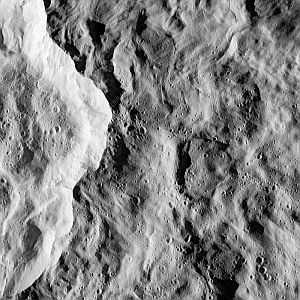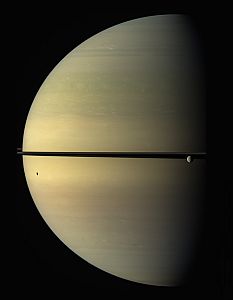
Für eine deutsche Übersetzung dieser Seite einfach die Brandenburger Flagge anklicken
 |
Click the Brandenburg Flag for a German translation Für eine deutsche Übersetzung dieser Seite einfach die Brandenburger Flagge anklicken |


|
|
IapetusA collection of pictures of Saturn's moon Iapetus
|
|



|
Iapetus is Saturn's third largest
moon. It consists mostly of ice with a small (20%) amount of rocky materials.
Iapetus was first visited in 1981 during the flyby of Voyager 2. During its time in orbit, Cassini delivered some amazing pictures. Here are our favorites. Like our other space galleries, the pictures have not been selected because of their scientific significance but because of their esthetic value and sometimes because of their historical importance.
Mosaic of 60 images taken by Cassini on September 10, 2007 from 45,000 miles (73,000 km). |

|
Iapetus was discovered on October 25, 1671 by Giovanni Cassini.
It was the second moon of Saturn to be discovered (after Titan by Huygens in 1655), and the first discovered by Cassini. The moon had baffeled astronomers for centuries, as it has two very different hemispheres and was often visible only when it was located on the western side of Saturn. The first closeup picture was taken by Voyager 2 during its flyby of the Saturn system on August 22, 1981. Voyager 2 took a good picture of the bright, trailing hemisphere, but the other, leading hemisphere was to dark for the probe's cameras. XXXXXXXX Iapetus' trailing hemisphere, taken by Voyager 2 from about 600,000 miles (965,600 km); source: NASA / JPL |

|


|
On July 1, 2004, the Cassini–Huygens probe, a collaboration between NASA, ESA, and
the Italian Space Agency, was inserted into Saturn's orbit. Cassini took the first closer images of Iapetus' leading and trailing hemispheres in order to solve the puzzle of the moon's two very different faces. (For moons locked in synchronous rotation, the leading hemisphere is the half of the moon leading the rotation around the planet). Cassini had discovered the moon in October 1671 on the western side of Saturn but was unsuccessful observing it on the eastern side. In 1705 with an improved telescope, Cassini found the moon to be two magnitudes dimmer on the estern side and correctly surmised that Iapetus has a bright and a dark hemisphere. Artist's concept of Cassini in Saturn's orbit; Source: NASA |

| The Cassini probe took the first close images of both hemispheres. There are still several theories as to how they developed. |

  Iapetus' bright and dark sides from 621,000 miles (1 mil. km); March 27, 2015 Source: NASA / JPL |
  Leading hemisphere from 446,000 miles (717,000 km); December 27, 2004 Source: NASA / JPL |
  trailing hemisphere from 45,000 miles (73,000 km); September 10, 2007 Source: NASA / JPL |

|
There is a huge difference in coloring between the two Iapetian hemispheres. The trailing hemisphere and the polar regions are bright, appearing with
a 10.2 magnitude to observers on Earth. The leading hemisphere is dark with a slight reddish-brown coloring. Observed from Earth, that hemisphere (when the moon is on Saturn's eastern side) appears with a magnitude of only 11.9 which is why Giovanni Cassini could observe the moon originally only when it was on Saturn's western side. Theories about the difference take into account the slow rotation period which results in different temperatures for both hemispheres as well as in-falling, reddish deposits from the Phoebe Ring, a distant disk, created by deposits from the moon Phoebe. XXXXXXXX Infrared image of the Phoebe-Ring, taken by the Spitzer Space Telescope; source: NASA / ESA / Wikipedia |

|

|
Today, thanks to the Cassini images, there are over 70 named surface features on Iapetus, most of them mountains and impact craters. The dark area on the leading hemisphere is called Cassini Regio; the bright trailing hemisphere is divided into On September 10, 2007, Cassini made one targeted close flyby, at a minimum range of 762 miles (1,227 km). In addition, Cassini took many pictures from larger distances, resulting in a complete map with over 70 named features (mostly mountains and craters) in 2014. |
  Color composit of leading hemisphere, taken on December 27, 2004 from 446,000 miles (717,000 km) and mosaic of trailing hemisphere, taken on September 10, 2007. Source: NASA / JPL
|

|
On July 1, 2004, the Cassini–Huygens probe, a collaboration between NASA, ESA, and
the Italian Space Agency, was inserted into Saturn's orbit. On November 26, 2005, the probe performed the first close approach of Rhea, passing the moon at 311 miles (500 km). Four more close approaches were done between 2007 and 2013. On January 11, 2011, Cassini got as close as 42.9 miles (69 km) to Rhea's surface, taking pictures of unprecedented resolution.
X |
  |

  Surface from 2,280 miles (3,670 km) March 9, 2013 Source: NASA / JPL |
  Surface from 317.5 miles (511 km) November 26, 2005 Source: NASA / JPL / sciencephoto.com |
  Surface from 124 miles (200 km) January 11, 2011 Source: NASA / JPL / astronomy.com |

|
The pictures above are some examples of high resolution closeup shots obtained during the close flybys. Click
Here to see NASA's image gallery of the flybys. Throughout the years, Cassini also took a number of pictures of Rhea from a distance, providing an insight into the interactions of the various bodies of the Saturn system. (below). |

  Rhea in front of Titan June 16, 2011 Source: NASA / JPL |
  Rhea's surface with Dione and Saturn's rings in the back January 11, 2011 Source: NASA / Planetary Society |
  Rhea behind Saturn's rings July 1, 2006 Source: NASA / i.pinimg.com |

 |

|
|
Enceladus above and Rhea below Saturn's rings December 19, 2016 Source: NASA / newatlas.com |
Rhea in front of Saturn November 4, 2009 Source: NASA / friendsofnasa.org |
  Global 3-Color map of Rhea, generated by Dr. Paul Schenk from Cassini images taken between 2004 and 2014; Source: Wikipedia.  
 

|